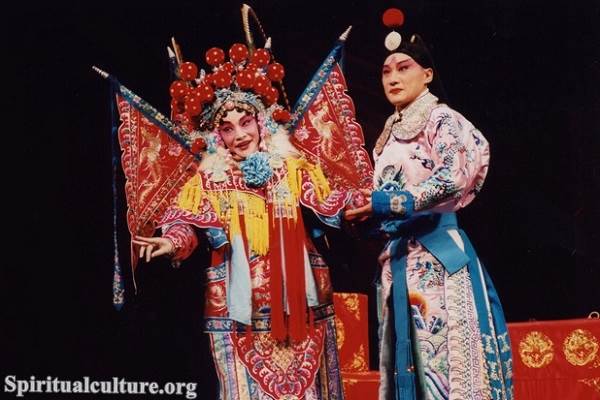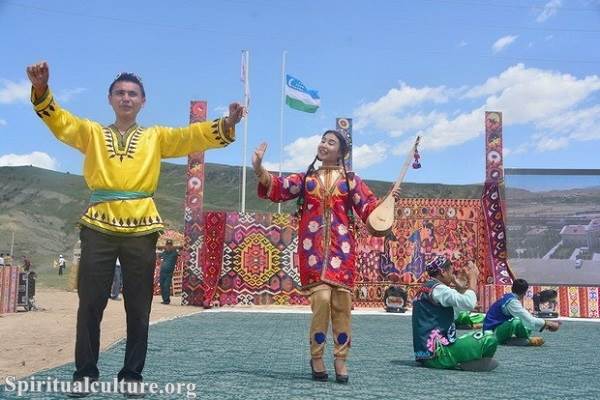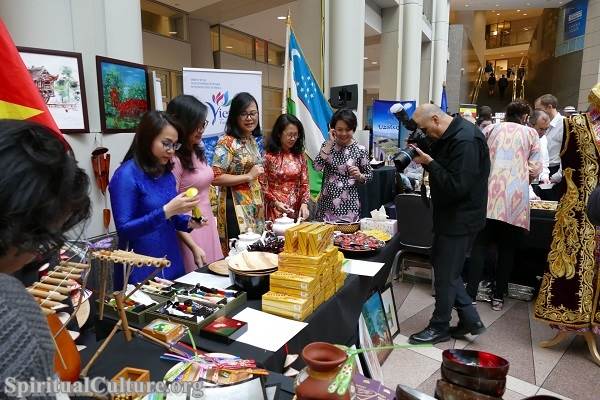South Korea’s cultural calendar is a profound tapestry woven with ancient spiritual rites, agrarian traditions, and celebratory modern artistry. These festivals are far more than mere events; they are vital, living expressions of the nation’s history, community bonds, and deep-seated reverence for nature and ancestry. At Spiritual Culture, we believe the true value of these celebrations lies in the continuity of the spirit—the rituals that connect the past to the present, binding families and communities in shared meaning.
Our ranking is designed to move beyond simple tourism statistics. Instead, we prioritize the festivals that carry the heaviest cultural weight, maintain the strongest links to Korean heritage, and offer the most profound insight into the nation’s spiritual cosmology, which is a unique blend of Confucianism, Buddhism, and Shamanism. These celebrations serve as critical vehicles for passing down intangible cultural assets, from ceremonial foods and traditional clothing (Hanbok) to millennia-old folk performances (Talchum).
Exploring this Top 10 list offers a pathway into the Korean soul. You will find that the most celebrated festivals are those tied to the lunar calendar, emphasizing cyclical renewal, filial piety, and gratitude for the earth’s bounty. We have diligently fact-checked the information to ensure historical and cultural credibility as of the Current Time of Writing, providing an authoritative and insightful guide to the true cultural heart of South Korea.
Table of the Top 10 Most Culturally and Spiritually Significant South Korean Festivals
| Rank | Festival Name (Korean) | Type | Primary Cultural Focus | Significance / UNESCO Status | Estimated 2025 Date |
|---|---|---|---|---|---|
| 1 | Seollal (설날) | National/Traditional Holiday | Ancestral Rites, Filial Piety, Renewal | Most important traditional holiday; marks age change. | January 29–31, 2025 (Lunar New Year) |
| 2 | Chuseok (추석) | National/Harvest Festival | Harvest Gratitude, Ancestral Worship (Charye) | Major harvest celebration (Korean Thanksgiving); strengthens family bonds. | October 6–8, 2025 (15th day of 8th Lunar Month) |
| 3 | Yeondeunghoe (연등회) | Buddhist/Cultural Festival | Buddha’s Birthday, Enlightenment, Peace | UNESCO Intangible Cultural Heritage of Humanity since 2020. | April 25–27, 2025 (Main events) |
| 4 | Gangneung Danoje (강릉단오제) | Folk/Shamanic Festival | Worship of Mountain Deities, Health, Ritual Arts | UNESCO Intangible Cultural Heritage of Humanity; one of Korea’s oldest festivals. | Approx. May 31 – June 7, 2025 (5th day of 5th Lunar Month) |
| 5 | Andong International Mask Dance Festival | Folk Art/Heritage | Traditional Mask Dance (Talchum), Social Satire | Preserves the national intangible heritage Talchum, recognized by UNESCO. | September 26 – October 5, 2025 (Approx.) |
| 6 | Jinju Namgang Yudeung Festival | History/Lantern Festival | Commemoration of 1592 Jinju Battle, Wishing Rites | Historical commemoration and visual ritual of releasing wish lanterns on the river. | October 1–13, 2025 (Approx.) |
| 7 | Gaecheonjeol (개천절) | National Foundation Day | Commemoration of the founding of Gojoseon (Korea’s first kingdom) | A secular holiday celebrating the spiritual origin of the Korean nation. | October 3, 2025 (Fixed Date) |
| 8 | Hwacheon Sancheoneo Ice Festival | Modern/Winter Festival | Community Resilience, Winter Harvest (fishing) | Modern success story built on community spirit and natural resources. | January 4–26, 2025 (Approx.) |
| 9 | Jinhae Gunhangje Festival | Seasonal/Nature Celebration | Nature’s Renewal, Military Heritage | The world’s largest cherry blossom festival, celebrating spring renewal. | March 24 – April 3, 2025 (Approx.) |
| 10 | Jeju Fire Festival (Jeju Olle Fire Festival) | Agrarian/Shamanic Rite | Field Burning Ritual (Bangae), Prayers for Good Harvest | Unique Jeju Island heritage, celebrating purification and agricultural success. | Early March 2025 (Approx.) |
Top 1. Seollal (Lunar New Year)
Seollal, or Lunar New Year, is undeniably the most important traditional festival in the South Korean cultural landscape, holding the sacred rank of number one in our Spiritual Culture guide. As of the Current Time of Writing, this three-day holiday marks a time when nearly the entire nation participates in a mass migration to their ancestral hometowns. It is the annual cornerstone of family life, where the focus is entirely on honoring the departed through elaborate ancestral rites (charye), wearing traditional Hanbok, and sharing special foods like tteokguk (rice cake soup), which symbolically adds a year to one’s age.
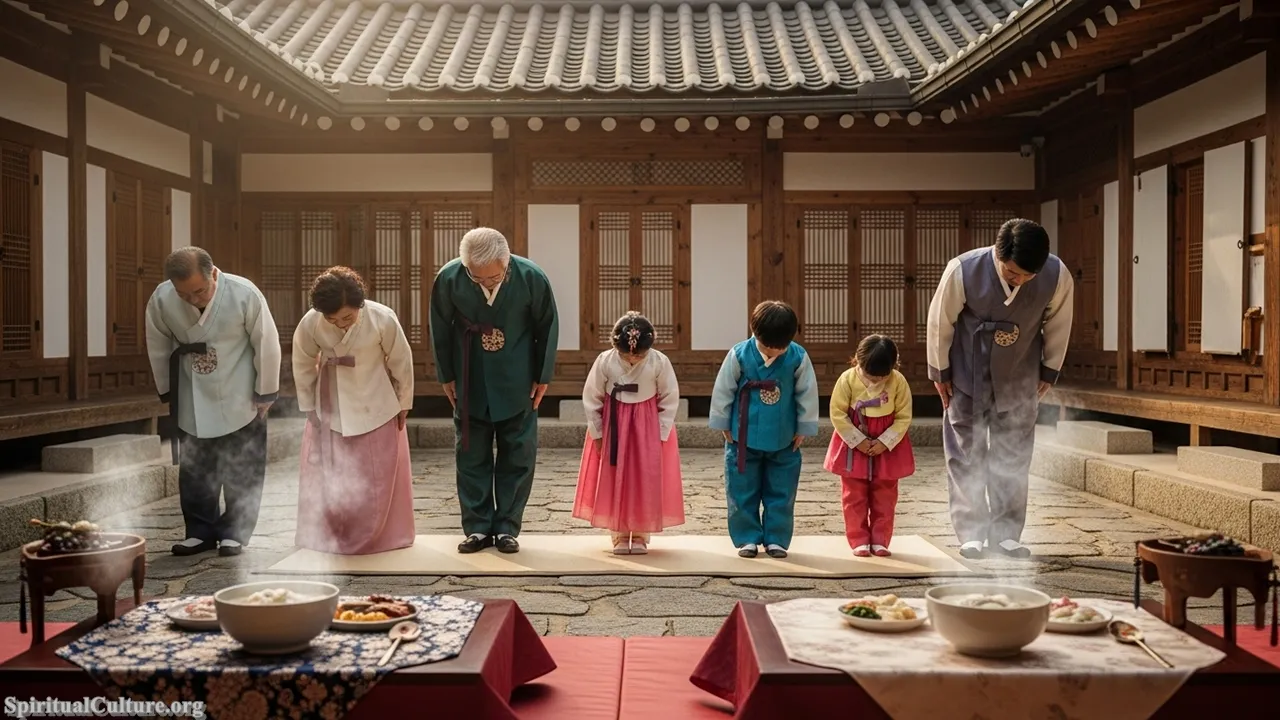
The spiritual impact of Seollal centers on the Confucian value of filial piety (hyo). The performance of charye and the ritual of sebae—a deep, formal bow by the younger generation to the elders—are profound acts of respect and submission to the family hierarchy. This festival is the moment when the spiritual lineage is visibly re-established, ensuring harmony between the living and the ancestors and securing blessings for the year ahead. The act of sharing tteokguk symbolizes the ritualistic cleansing of the past year and the pure, white beginning of the new.
The enduring power of Seollal is its role as the national anchor of identity. While modern life is increasingly globalized, this festival enforces a yearly return to fundamental values: the appreciation of one’s roots, the gratitude for the sacrifices of previous generations, and the communal hope for prosperity. Its preservation is not just cultural—it is existential, ensuring the continuity of the Korean family unit and its core spiritual ethics.
Cultural/Spiritual Highlights
- Charye: Formal ancestral memorial rites held in the home.
- Sebae: The ritual bow to elders, receiving blessings and gift money (sebaetdon).
- Tteokguk: Eating this rice cake soup symbolizes gaining another year of age and spiritual renewal.
- Folk Games: Traditional pastimes like Yutnori (a board game) are played to divine the year’s fortune.
Top 2. Chuseok (Harvest Festival)
Chuseok, often referred to as Korean Thanksgiving, stands as the second-most culturally significant festival, celebrated on the 15th day of the 8th lunar month. As a major harvest festival as of the Current Time of Writing, its very essence is built on gratitude—a primal spiritual acknowledgment of the earth’s bounty. Like Seollal, it involves a national migration as families return home to perform ancestral rites, using the newly harvested rice and fruits to show respect and thanks to their progenitors for ensuring a good yield. This connection to the land and the ancestors makes it an irreplaceable fixture of Korean heritage.
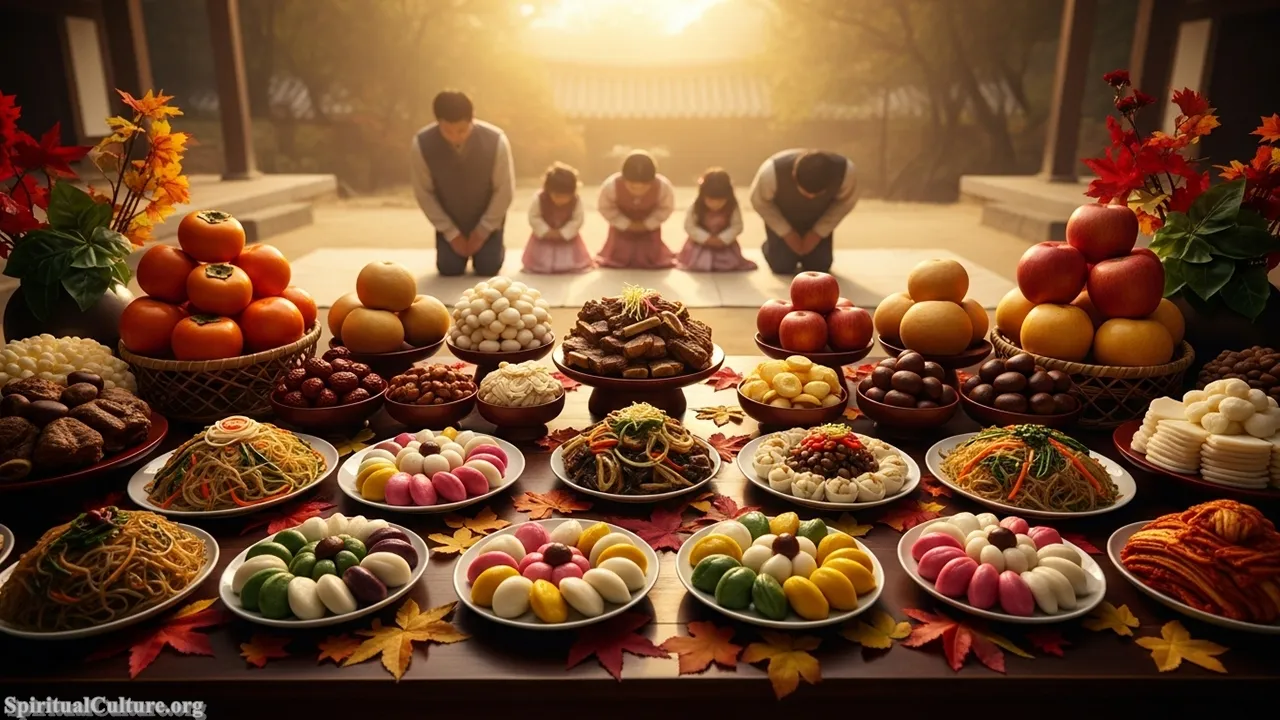
The spiritual impact of Chuseok is deeply rooted in the agricultural cycle and the Confucian respect for ancestors. Families visit ancestral graves (seongmyo) to tidy them (beolcho) and present offerings in a formal memorial service. This act of tending the graves is a physical manifestation of filial piety, directly linking the prosperity of the living to the care and respect shown to the departed. The sharing of foods like songpyeon (half-moon shaped rice cakes, representing a full moon and a wish for a better future) binds the community together in a collective expression of thanks and hope.
Chuseok reinforces the profound moral lesson that all prosperity stems from the past and the land. By dedicating this national holiday to ancestral gratitude, South Korea continually re-affirms its commitment to a heritage that values humility and interdependence. The preservation of this festival ensures that the modern, urbanized population maintains a tangible link to the nation’s agrarian and spiritual foundations.
Cultural/Spiritual Highlights
- Seongmyo/Beolcho: Visiting and cleaning ancestral graves, a direct sign of respect.
- Songpyeon: Special rice cakes made with new harvest ingredients, signifying community and fortune.
- Charye Rituals: Ancestral rites held using the season’s first harvest.
- Ganggangsullae: A traditional folk circle dance performed under the full harvest moon, symbolizing harmony.
Top 3. Yeondeunghoe (Lotus Lantern Festival)
The Yeondeunghoe, or Lotus Lantern Festival, is a spectacular manifestation of South Korea’s Buddhist spiritual heritage. Organized annually to celebrate Buddha’s Birthday, this festival’s spiritual significance was formally cemented by its 2020 inscription on the UNESCO Representative List of the Intangible Cultural Heritage of Humanity. As of the Current Time of Writing, its dazzling display of over 100,000 lanterns in Seoul—crafted by participants from all over the world—transforms the urban environment into a vibrant space of contemplative light and color.
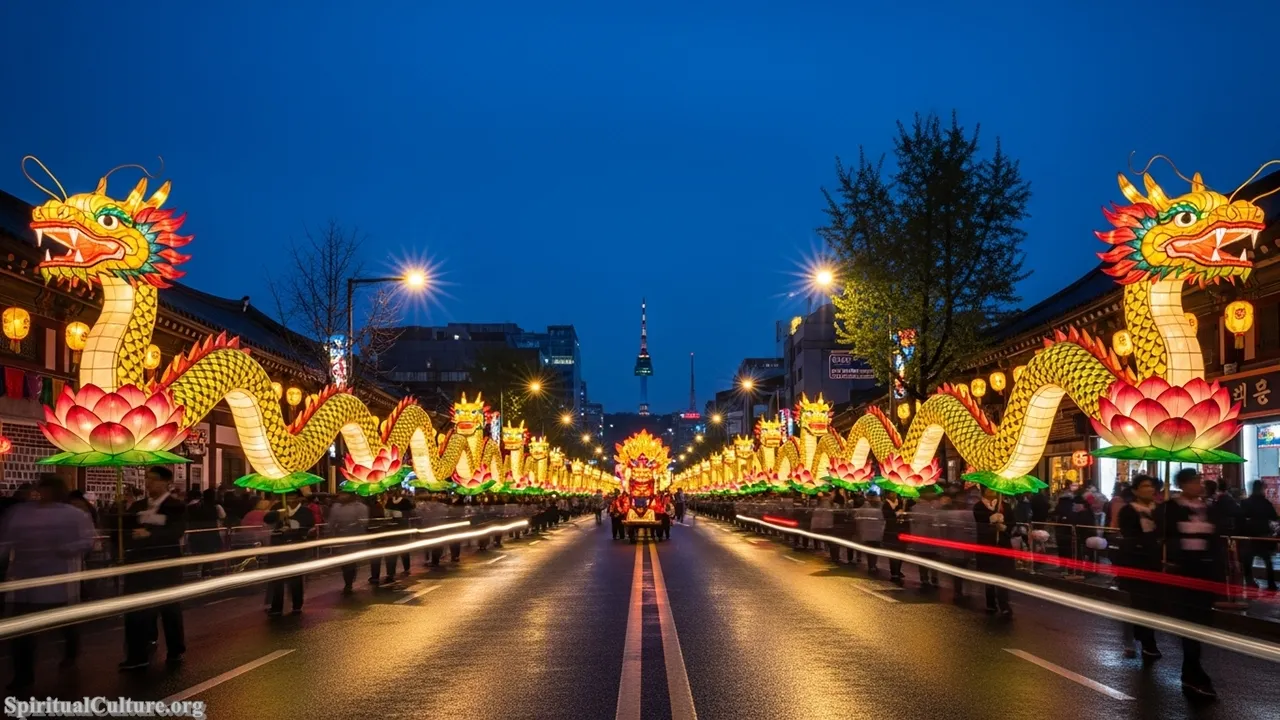
The spiritual impact of the Yeondeunghoe is the deep symbolism of the lantern itself. In Buddhist tradition, the lantern is lit to “illuminate the dark,” symbolizing the wisdom of the Buddha that dispels ignorance and suffering. The ritual of lighting and parading the lanterns is a collective prayer for enlightenment, peace, and the harmonious well-being of the world. It is a profoundly humanistic festival, celebrating not only the birth of the Buddha but the potential for inner light and compassion within every person, bridging religious and secular boundaries.
The festival’s global recognition by UNESCO highlights the importance of preserving this tradition as a universal expression of human hope and community spirit. It serves as a moral lesson in the power of light over darkness and inclusion over exclusion, inviting everyone to participate in the act of wishing for a better world. The tireless preservation efforts ensure that this ancient spiritual practice remains a dynamic and relevant cultural force.
Cultural/Spiritual Highlights
- UNESCO Inscription: Recognized as an Intangible Cultural Heritage of Humanity (2020).
- The Lantern Symbol: Represents the wisdom of the Buddha illuminating the world.
- Dharma Ceremony: Official ceremonies at Jogyesa Temple emphasizing Buddhist teachings.
- Collective Prayer: The lantern parade is a mass ritual for peace, happiness, and social harmony.
Top 4. Gangneung Danoje
The Gangneung Danoje is one of South Korea’s oldest surviving festivals, with historical roots tracing back over 1,000 years. Celebrated on the 5th day of the 5th lunar month (Dano), this festival of spring and the summer solstice holds massive spiritual and heritage value, having also been inscribed on the UNESCO Intangible Cultural Heritage of Humanity list. As of the Current Time of Writing, it is a regional cultural phenomenon centered on the worship of the mountain and village deities, serving as a critical link to Korea’s pre-Buddhist and pre-Confucian shamanic past.
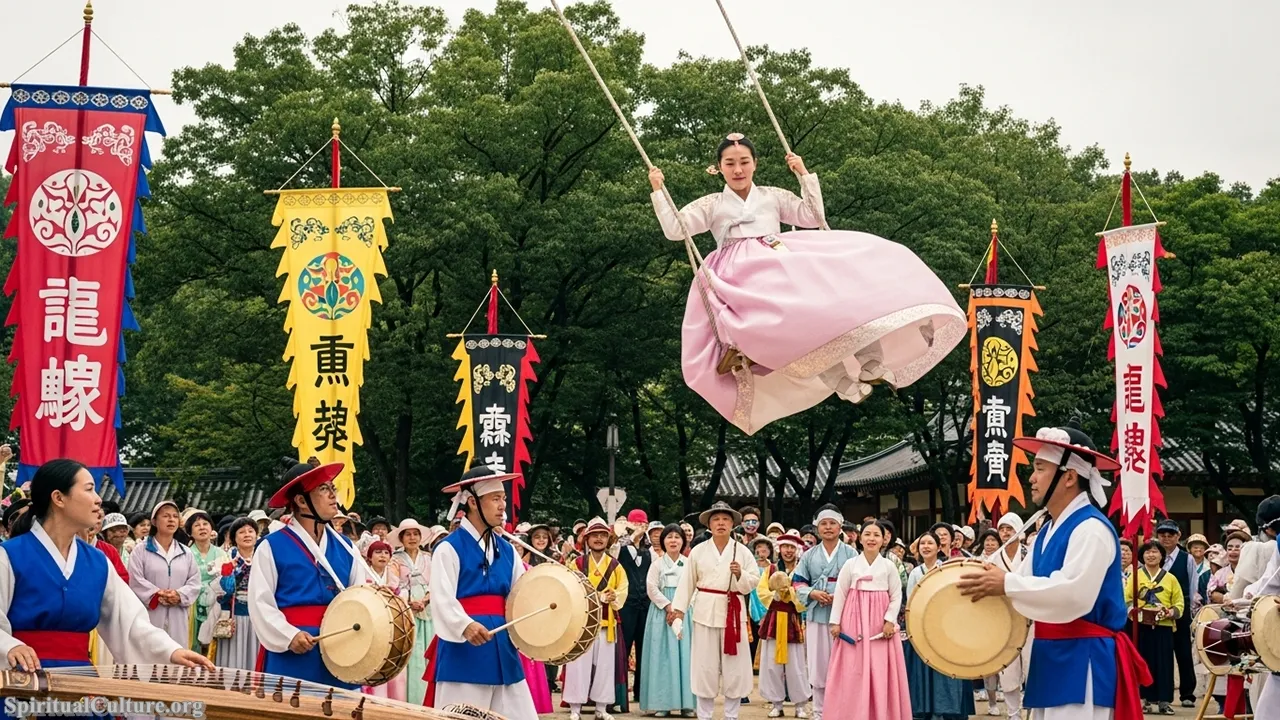
The spiritual impact is fundamentally an appeal to the cosmos and nature for well-being. The festival includes complex shamanic rituals (gut) directed at the mountain spirit (Daegwallyeong Guksa Seonghwang) and the village deities, praying for abundant harvests and the health of the community. Traditional customs like washing hair with iris-infused water (believed to bring health and beauty) and swinging competitions (geunettwigi) are acts of purification and seasonal transition, reinforcing the deep, ancient bond between the people and the natural world.
The preservation value of the Gangneung Danoje cannot be overstated; it is a live cultural museum that actively transmits ancient shamanic performance arts, oral traditions, and traditional music to younger generations. The moral lesson is the necessity of ritual in maintaining balance—between humanity and nature, and between the physical world and the spiritual realm—a powerful reminder that gratitude must precede prosperity.
Cultural/Spiritual Highlights
- UNESCO Inscription: Recognized as an Intangible Cultural Heritage of Humanity.
- Shamanic Rites (Gut): Ritual performances to honor and appeal to local deities.
- Suryeom/Changpo-mul: Ritual hair washing with iris water for spiritual cleansing and health.
- Gwanno Mask Play: Korea’s only surviving Dano-related masked dance drama.
Top 5. Andong International Mask Dance Festival
The Andong International Mask Dance Festival is a global celebration of Talchum, the Korean traditional mask dance, which is itself recognized as a UNESCO Intangible Cultural Heritage. Held annually in Andong, a city famous for its preserved Joseon Dynasty architecture and Confucian culture, this festival acts as a vibrant conduit for folk history and performance art. It showcases the region’s unique Hahoe Byeolsingut Talnori, which blends religious ritual with social satire, making it a critical cultural event as of the Current Time of Writing.

The spiritual impact of the mask dance stems from its origins in shamanic ritual and its subsequent evolution into a form of social commentary. The masks (Tal) were historically believed to harbor spirits, and the performances were initially a type of gut to ward off evil spirits and pray for a good harvest. By symbolically mocking corrupt officials, privileged elites, and patriarchal norms, the dances provide a vital spiritual release, allowing the common people to critique society in a safe, ritualized space, thus promoting community harmony and justice.
The moral lesson embedded in the Andong Mask Dance is the redemptive power of satire and the importance of using art to speak truth to power. The festival’s preservation efforts ensure that Talchum—a complex art form involving dance, music, drama, and spirituality—is maintained and celebrated both nationally and globally. It reminds us that culture is a tool for both worship and ethical correction.
Cultural/Spiritual Highlights
- Talchum Preservation: Actively conserves a UNESCO-recognized intangible heritage art form.
- Ritual Roots: Mask dances originated as shamanic rituals to drive out evil spirits.
- Social Catharsis: The performance acts as a communal spiritual and social pressure release.
- Hahoe Village Link: Deeply connected to the UNESCO World Heritage Hahoe Folk Village.
Top 6. Jinju Namgang Yudeung Festival
The Jinju Namgang Yudeung Festival transforms the Nam River in Jinju into a spectacular canvas of light, carrying immense historical and cultural gravity. The festival is rooted in the 1592 Imjin War, where the people of Jinju used floating lanterns to communicate with forces outside the besieged city and to prevent Japanese troops from wading across the river. As of the Current Time of Writing, this spectacle has evolved into a national celebration that honors the spirits of the 70,000 soldiers and civilians who perished in the battle.
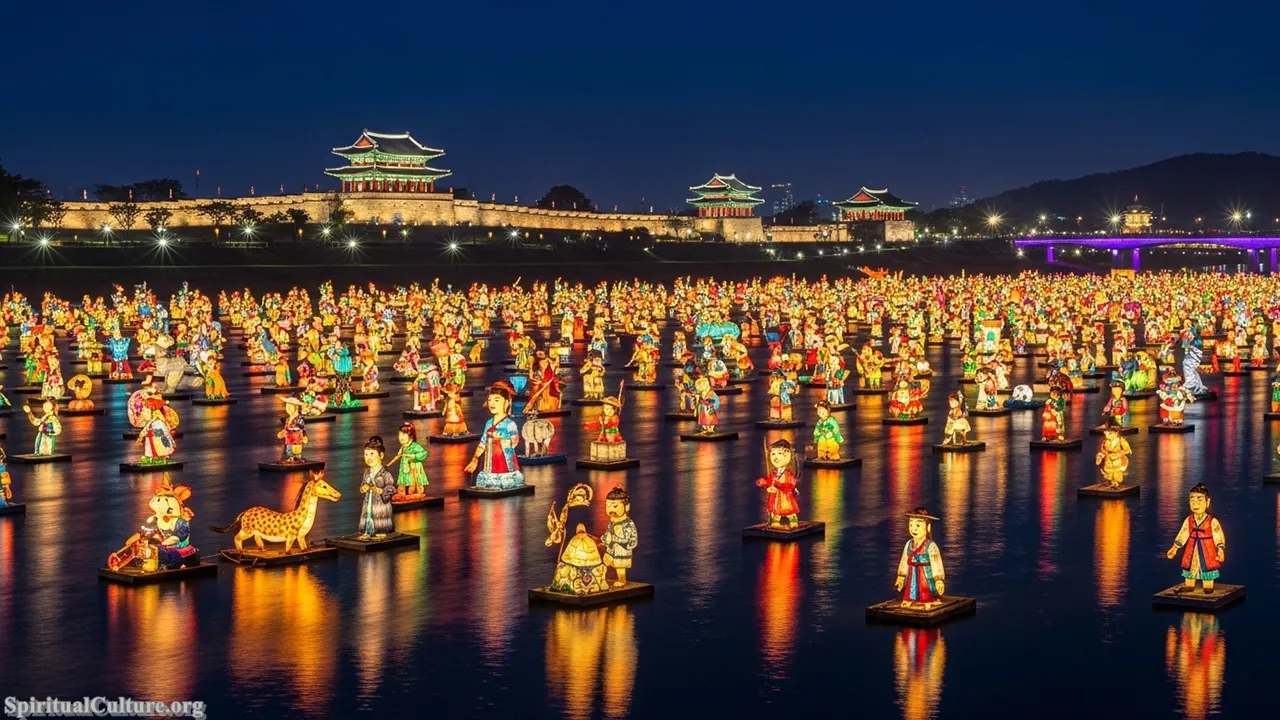
The spiritual impact is profoundly commemorative and ritualistic. The act of lighting and floating a wish lantern on the river is a symbolic gesture to guide the spirits of the fallen home, offering prayers for peace, and making wishes for the well-being and prosperity of one’s own family. Each lantern is an individual prayer or act of remembrance, but the collective illumination represents a national spiritual unity—a light of hope rising from a deep historical tragedy. The visual grandeur is inseparable from its solemn, historical meaning.
The moral lesson of the Jinju Lantern Festival is resilience and sacrifice. It ensures that the memory of historical courage remains brightly illuminated, turning a moment of defeat into an annual ritual of spiritual triumph and community hope. The preservation of the festival’s historical context allows modern South Koreans to connect viscerally with the nation’s foundational struggles and the strength of its spirit.
Cultural/Spiritual Highlights
- Historical Commemoration: Honors the spirits of those lost in the 1592 Jinju Battle.
- Yudeung Ritual: Floating lanterns on the river to guide the spirits of the deceased.
- Wish Lanterns: Participants light lanterns with personal prayers for health and success.
- National Symbolism: Represents the enduring spirit and resilience of the Korean people.
Top 7. Gaecheonjeol (National Foundation Day)
Gaecheonjeol, or National Foundation Day, is a vital national holiday celebrated every October 3rd, commemorating the legendary founding of Gojoseon, the first Korean kingdom, by the divine figure Dangun Wanggeom in 2333 B.C.E. While it is a secular national holiday as of the Current Time of Writing, its significance is deeply spiritual, resting on the idea of a shared, quasi-mythological national ancestor and the “Opening of Heaven” (Gaecheon) that birthed the Korean nation. It is the annual affirmation of Korea’s foundational narrative and sovereignty.

The spiritual impact is woven into the concept of national identity. The holiday’s rituals, often including ceremonies at the Chamseongdan altar on Mani Mountain (believed to have been built by Dangun himself), serve as an acknowledgment of the Korean people’s divine or sacred origins. This shared spiritual mythos transcends regional and political differences, providing a unifying foundation for the Korean identity. It is a mass spiritual reflection on the beginning of the nation’s 5,000-year history.
The celebration’s preservation is paramount as it continually grounds the modern republic in its ancient roots, offering a moral lesson about the sacred nature of the homeland and the shared destiny of its people. By celebrating the “Opening of Heaven,” Koreans affirm a belief in a lofty national purpose, encouraging patriotic pride and a commitment to the collective good.
Cultural/Spiritual Highlights
- Dangun Wanggeom: Honors the mythical founder of the first Korean kingdom (Gojoseon).
- Chamseongdan Rites: Rituals held at the ancient altar on Mani Mountain to honor the founder.
- Gaecheon (Opening of Heaven): Commemorates the spiritual moment of national inception.
- Symbol of Sovereignty: Reinforces the spiritual and historical legitimacy of the Korean nation.
Top 8. Hwacheon Sancheoneo Ice Festival
The Hwacheon Sancheoneo Ice Festival is a comparatively modern phenomenon that has rapidly grown into one of the world’s largest winter festivals, drawing millions of visitors to Hwacheon in Gangwon Province. Although it does not possess the ancient ritualistic heritage of the top-ranked festivals, its spiritual significance lies in its celebration of community resilience, the abundance of nature, and the joyful triumph over the harsh winter elements. As of the Current Time of Writing, it is a powerful demonstration of local resourcefulness and mass communal celebration.
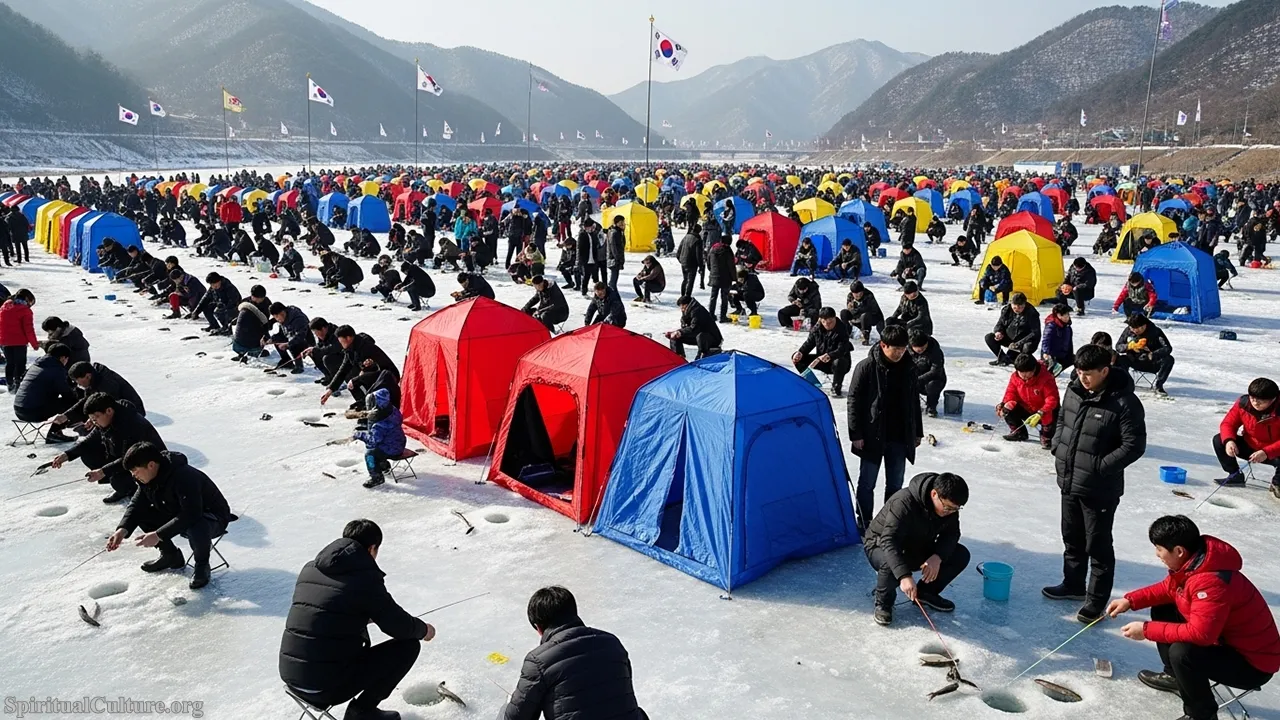
The spiritual impact is a localized, modern-day expression of the agrarian belief in a seasonal “harvest,” in this case, the sancheoneo (mountain trout) caught through holes drilled in the frozen river. The traditional custom of ‘bare-hand fishing’—where participants plunge into the icy water—is a modern baptismal rite of courage and a playful acknowledgment of the body’s connection to nature. The festival provides a collective psychological release from winter’s constraints, emphasizing abundance and communal sharing.
The festival serves as a modern moral lesson in community vitality and sustainable resource management. It demonstrates that cultural celebration can be successfully built around local ecological value, revitalizing an area through collective joy and shared experience. Its massive popularity ensures the preservation of winter folk traditions in a contemporary, accessible format.
Cultural/Spiritual Highlights
- Sancheoneo Harvest: Modern celebration of a seasonal, natural abundance.
- Bare-Hand Fishing: A playful, cathartic ritual of conquering the cold and connecting with nature.
- Community Resilience: Showcase of local ingenuity to turn winter hardship into celebration.
- Ice Sculptures: Art reflecting the temporary beauty and purity of the winter season.
Top 9. Jinhae Gunhangje Festival
The Jinhae Gunhangje Festival is celebrated annually in Jinhae, Changwon, and has earned the title of the world’s largest cherry blossom festival. While its primary draw is the breathtaking natural spectacle of hundreds of thousands of cherry trees blooming, its historical and cultural significance is rooted in the commemoration of Admiral Yi Sun-sin, a revered national hero. As of the Current Time of Writing, it perfectly blends a spiritual celebration of spring renewal with patriotic commemoration.
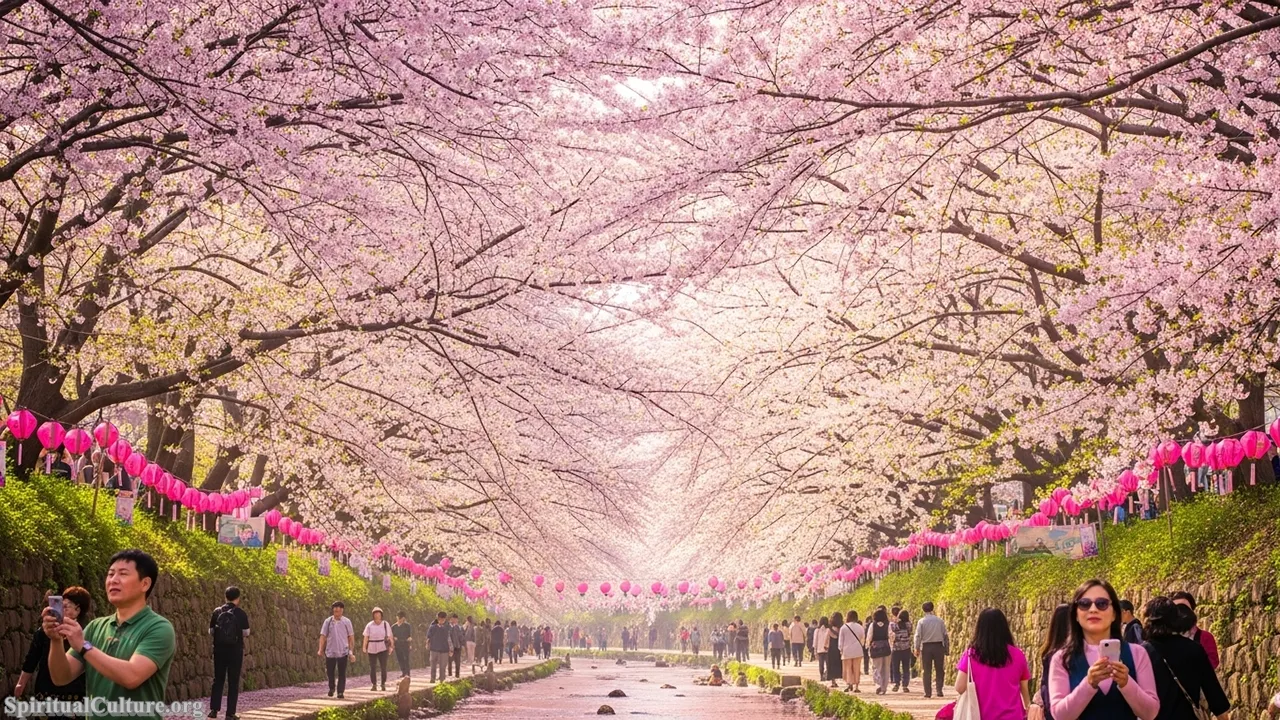
The spiritual impact is dual. Firstly, the mass viewing of the cherry blossoms is a profound national ritual of celebrating the cyclical return of life and the ephemeral beauty of nature—a moment of reflective beauty deeply valued in East Asian culture. Secondly, the festival’s origin as a memorial service for Admiral Yi Sun-sin imbues it with a deeper, patriotic spirituality. The ceremonial parades and naval displays honor his spirit and sacrifice, teaching a moral lesson about duty and protection of the nation.
The preservation value of the festival lies in its ability to marry natural wonder with historical memory. The annual blooming serves as a recurring metaphor for national renewal and the sacrifice required for peace. Its overwhelming celebratory nature is a collective affirmation of hope, ensuring the cultural remembrance of both a national hero and the profound spiritual joy found in nature’s cycle.
Cultural/Spiritual Highlights
- Admiral Yi Sun-sin: Honors the spirit of the great Joseon Dynasty naval hero.
- Nature’s Renewal: A massive communal celebration of spring and the cycle of life.
- Ephemerality: Reflects on the transient beauty of life and nature (a Buddhist influence).
- Military Parades: Commemorative displays emphasizing national defense and duty.
Top 10. Jeju Fire Festival (Jeju Olle Fire Festival)
The Jeju Fire Festival, or Jeju Olle Fire Festival, is a unique cultural event deeply rooted in the island’s pastoral and shamanic traditions. It is based on the ancient practice of bangae, where villagers would burn fields in late winter to clear old grass and eliminate pests, ensuring a richer spring pasture for their livestock. As of the Current Time of Writing, the festival centers on the ritualistic burning of a massive conical bonfire (oreum) to pray for a good harvest, health, and prosperity.

The spiritual impact of the festival is one of purification and communal blessing. The fire is seen as a potent cleansing agent, driving out evil spirits (as noted in Shamanic tradition) and symbolizing the passionate hope for a new beginning. The sight of the burning oreum—often a small parasitic cone—is a powerful communal ritual, invoking ancient ties to the land and the unique spiritual landscape of Jeju Island, which includes the worship of volcanic deities.
The preservation of this festival ensures the continuity of Jeju’s distinct cultural heritage, which differs significantly from the mainland. The moral lesson is the necessity of purification—the willingness to let go of the old and the bad (clearing the field/burning the fire) in order to make space for the new and the prosperous. It is an annual, visceral commitment to a pure beginning rooted in the power of fire and community intention.
Cultural/Spiritual Highlights
- Bangae Tradition: Based on the ancient pastoral ritual of field burning for purification.
- Oreum Bonfire: Lighting a massive fire on a small volcanic cone to invoke good fortune.
- Shamanic Purification: Fire is used to drive away evil spirits and bring health.
- Jeju Identity: Preserves the unique spiritual and agricultural heritage of the island.
Conclusion
From the solemn ancestral rites of Seollal and Chuseok to the dazzling spiritual illumination of the UNESCO-recognized Yeondeunghoe, South Korea’s most famous festivals are vibrant testimonies to a national spirit that prizes continuity, piety, and resilience. Our exploration at Spiritual Culture confirms that the fame of these events is justly earned, not merely by spectacle, but by the profound depth of their cultural and historical roots. They are critical to understanding the nation, acting as yearly reset buttons that reaffirm communal values and ancestral reverence.
These celebrations—whether they are ancient folk traditions like the Gangneung Danoje or modern community spectacles like the Hwacheon Ice Festival—teach us that true culture is a living, breathing commitment to memory and moral order. They are the collective prayers of a nation, ensuring that the past is honored, the present is joyful, and the future is blessed. We celebrate these magnificent expressions of the Korean soul and encourage all to witness their power.


